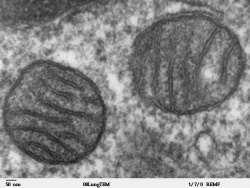Template:Main Page News: Difference between revisions
From Embryology
mNo edit summary |
mNo edit summary |
||
| Line 3: | Line 3: | ||
| colspan=2|<span style="font-size:150%">'''Three-person embryos'''</span> | | colspan=2|<span style="font-size:150%">'''Three-person embryos'''</span> | ||
|-bgcolor="F5FAFF" | |-bgcolor="F5FAFF" | ||
| | | valign=top|[[File:Mitochondria EM01.jpg|250px|left]] | ||
[[File:Mitochondria EM01.jpg|250px|left]] | | '''UK government has voted to legalize a gene-therapy technique that could help women to avoid passing genetic defects onto their children.''' | ||
| '''UK has voted to legalize a gene-therapy technique that could help women to avoid passing genetic defects onto their children.''' | |||
The technique called either "mitochondrial replacement" or "three-person in vitro fertilization" intention is to prevent maternal mitochondrial mutations to be passed on to children. Its estimated that estimated 1 in 5,000 children are born with these type of diseases caused by such mutations. | The technique called either "mitochondrial replacement" or "three-person in vitro fertilization" intention is to prevent maternal mitochondrial mutations to be passed on to children. Its estimated that estimated 1 in 5,000 children are born with these type of diseases caused by such mutations. | ||
Revision as of 12:18, 7 February 2015
| Three-person embryos | |
| UK government has voted to legalize a gene-therapy technique that could help women to avoid passing genetic defects onto their children.
The technique called either "mitochondrial replacement" or "three-person in vitro fertilization" intention is to prevent maternal mitochondrial mutations to be passed on to children. Its estimated that estimated 1 in 5,000 children are born with these type of diseases caused by such mutations.
| |
